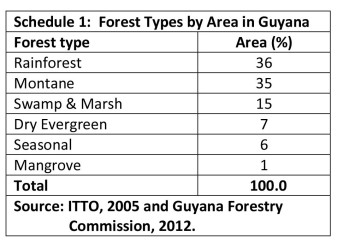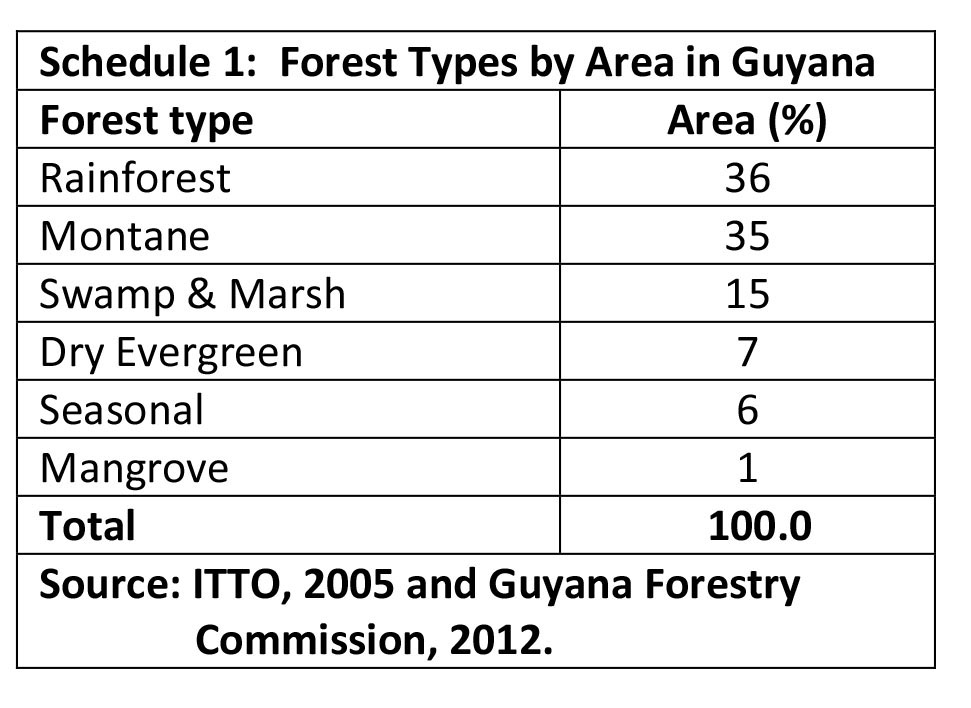Method
March 21 was International Day of the Forest, 2016. Its thematic focus was “to shine a spotlight on the connections between forests, water systems, and sustainable development”. It is appropriate therefore, that today’s column is devoted to providing additional details on Guyana’s forests, directly related to this theme.
 As previously indicated, the information provided comes mainly from the United Nations, Food and Agricultural Organisation (FAO), Global Forest Resources Assessment (FRA), 2015. From the outset of this presentation, readers have queried me on the methods used by the FAO to arrive at the estimates provided in its FRAs. In an accompanying Note to each Report, the FAO describes the method utilized.
As previously indicated, the information provided comes mainly from the United Nations, Food and Agricultural Organisation (FAO), Global Forest Resources Assessment (FRA), 2015. From the outset of this presentation, readers have queried me on the methods used by the FAO to arrive at the estimates provided in its FRAs. In an accompanying Note to each Report, the FAO describes the method utilized.
For 2015, the FAO indicated it continues to rely on official submissions by national governments; however, the detailed methods employed have evolved over time. No longer are questionnaires sent to national governments for completion and return. Starting with the FRA 2005, the FAO has “devolved statistical estimation of the forest to National Correspondents (NCs)”. Although these NCs operate on behalf of their governments, they are given “strict instructions, in detailed guidance documents, on how to submit their forest information, using FAO’s definitions and reporting framework”. To recall, the FAO’s forest definition is land-use based, in a world where there are more than 800 different definitions embodied in various forest laws and regulations!
Location and forest type
Guyana’s forests are located within the Guyana Shield Rainforest region, which readers would know is contiguous to the 6.7 million km2 Amazon Basin. While, as we noted, published definitions of forests vary, the classifications of Guyana forests listed in the Schedule below is the one most commonly applied. This indicates six major forest types: rainforest, montane forest, swamp and marsh forest, dry evergreen forest, seasonal forest and mangrove forest. The percentage distribution afforded to each forest type is provided in the Schedule.
As can be seen from the Schedule, rainforest, montane forest, and swamp marsh forest account for the vast majority of forest types (86 per cent), with mangroves very marginal (1 per cent).

Biodiversity in Guyana’s forest
While, as I have previously indicated, there is considerable variation in published definitions of the global forest and also its classification; there is, as far as I can determine as a non-specialist, considerable agreement in available published material that Guyana’s forest is one of the best conserved, as well as one of the most expansive areas of untouched tropical rainforests. (World Resources Institute, WRI)
Guyana’s forest is reputed to support a striking amount of bio-diversity. Scientific reports indicate that there are more than 1,200 vertebrate species; and over 8,000 plant species (WRI, and International Tropical Timber Organisation, ITTO). Many of these species are also reputed to be endemic to the region and/or vulnerable. The International Union for Conservation of Nature (IUCN) 2014, has placed 68 of these species on its Red List of threatened/vulnerable species.
Guyana’s national bio-diversity is a crucial asset for promoting its sustainable growth and development (for example, agriculture, forestry and fisheries), as well as for the wider global community (for example, climate regulation, provisioning of global freshwater systems, and broader ecosystems sustainability). Threats to the preservation of Guyana’s bio-diversity arise mainly from drivers of deforestation. I shall consider this issue more fully in later columns. Meanwhile, it is worth observing at this point, national reviews of Guyana’s biodiversity threats have singled out: 1) overfishing, 2) depletion of mangroves, 3) expansion of extractive industries and 4) new settlements. These are indicated here, in no particular order of ranking.
Strategy and Action Plan
It is useful to note that, at this juncture, and starting in the period 1999-2004, Guyana had produced a National Biodiversity Strategy and Action Plan (NBPA) and the Mainstreaming of its Bio-diversity. The NBPA was reviewed by the Environmental Protection Agency in 2004, and a second version was prepared, covering the period 2007-2011. This latter appears to have morphed into the objectives of 1) the Low Carbon Development Strategy (LCDS), 2) the Aichi Biodiversity Targets for 2011-2020, and 3) the 2015-2025 National Action Plan (NAP), which has been “aligned” to Guyana’s commitments under the United Nations Convention to Combat Desertification (UNCCD) 10 Year Strategy (2008-2018). The last highlights the connection between forests and water systems, identified in this year’s International Day of the Forest.
The present series of columns is aimed at reviewing the forest sub-sector of the extractive industries. It is not the intention to dwell at any length on these important domains affecting the state of Guyana’s forest. It should however be registered up front that, the NBAP is aimed at 1) promoting and achieving the conservation of Guyana’s biodiversity 2) using its components in a sustainable way and 3) promoting fairness and equity in the sharing of benefits arising out of the use of its biodiversity. And, because of these aims, it has focused on four thematic areas: first, the forests; second, agriculture; third, coastal resources; and, fourth, marine and freshwater resources.
Conclusion
I shall return to some aspects of this topic in coming columns, but in conclusion it should be noted here that Guyana has ratified the United Nations Convention on Biodiversity (UNCBD) and is bound by its Aichi Biodiversity Targets, referenced above. In its Fourth National Report on Guyana, the UNCBD has observed: “Guyana has taken significant steps toward meeting the obligations and ensuring conservation and protection of its natural resources” as stated in the UNCBD Strategic Plan 2011-2020.
Next week I continue with this discussion of the key characteristics of Guyana’s forest.










